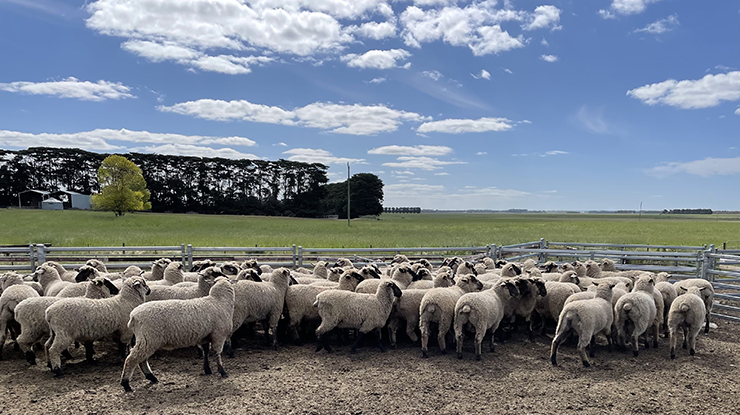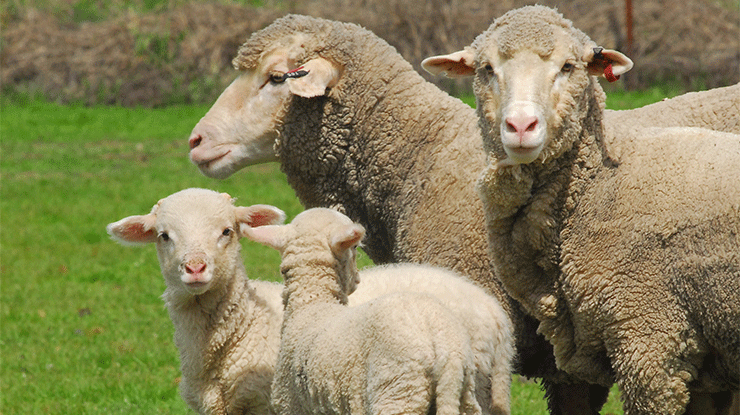
Spring hub
MLA has compiled this suite of resources, tips and tools to support your on-farm decision making during spring.
Producers can reduce weeds and extend the life of established pastures by optimising hay and silage production this spring. Check out this free eLearning package to find out more.
The EverGraze Feedbase Planning and Budgeting Tool is designed to help you to plan your rotational grazing systems, determine appropriate stocking rates, calculate your pasture growth rates, determine how long your paddocks will last and calculate the most economical ration for your stock. You can now also keep track of the carrying capacity (stocking rate) of each paddock by recording your dry sheep equivalent grazing days/ha. Maintenance fertiliser requirements can then be calculated.’
The Stocking Rate Calculator works out the monthly stocking rate in dry sheep equivalents per hectare (DSE/ha) throughout the year by adding together the stock numbers of each class and their DSE rating in a given month. This calculator is also available within the Feed Budget and Rotation Planner (see above).
This tool is intended to assist P fertiliser decisions for temperate, legume-based pastures grazed by sheep and beef cattle on acid soils in southern Australia.
The EverGraze Pasture Improvement Calculator will help to work out the costs and benefits of resewing pastures. The tool allows inputs for costs of resewing, the benefits of the resewn pastures to livestock, soils and the environment at any given financial values (i.e. different interest rates, tax rates, gross margins etc).
The Cost of Production Calculator takes data on production, livestock enterprise costs, labour and overheads, and delivers both a ‘cost of production per kilo’ figure for the business and a picture of how it compares with other properties across Australia.
Weeds hub (southern Australia)

SA sheep producer Anthony Pearce is well aware of the value of accurate genetic data, given his experiences as stud principal of Telpara Suffolk stud in Hartley, which sells a selection of high-performance rams and ewes each year.
Within his breeding operation, he concentrates on Australian Sheep Breeding Values (ASBVs) that increase growth traits while maintaining intramuscular fat, using the Terminal Carcase Production (TCP) index. For each, it’s important that he has reliable data to use and share with clients.
It’s the same story when he’s purchasing genetics, as he needs to know the ASBVs on rams he selects are accurate and that they are going to perform.
These are just two of the reasons why Anthony was motivated to co-invest in the satellite flocks as part of MLA Resource Flock project, contributing two rams of his own.
While progeny testing is expensive and also increases the generation interval, it gives a very high accuracy of ASBVs for the sires tested.
Along with submitting his own rams, as President of the Suffolk Sheep Society of Australia, Anthony also felt it important to let members know about the co-investment opportunity and encourage their participation to strengthen the breed.
“If you were to look at the reference populations of IMF alone in LAMBPLAN in August 2020, you’d have seen that there were 6,100 Poll Dorset animals contributing, but only 900 Suffolks,” Anthony said.
“We knew that we needed to build up our reference population, because the larger and more diversified it is for the carcase traits of interest to us, the more accurate it will be to underpin the use of genomics in Suffolk flocks.
“In late 2020, I approached our members calling for their involvement, and we saw a great response, being able to contribute two Suffolk eating quality satellite flocks to the project.”
Group effort
Anthony said the most important part of the project to convey to members was that participation wasn’t about individual success or finding the best ram, but about improving the overall quality of the breed through wider measurement of carcase traits on a diverse range of sires.
“We knew participating in the satellite flock wasn’t a profit-making exercise, but also understood that doing nothing to progress the genetics of our breed would be more costly overall than a short-term investment like this, which is why we got involved,” he said.
“In 2–5 years, there’s going to be an even greater requirement to produce lambs that have good eating quality, are high yielding and fast growing.
“A lot of the traits associated with these, like intramuscular fat for marbling, shear force, lean meat yield and carcase weight, are typically hard to measure and so are difficult to improve, but we have an opportunity to do so through the satellite flocks.
“The benefit of the project lies in this data, as it will underpin genomic prediction for Suffolks and ensure continued genetic progress so that we don’t get left behind by larger breeds of meat sheep.”
The Suffolk satellite flock completed data capture on their 2021 cohort by late December last year, with DNA samples and meat science traits collected on all project lambs.
Applying results
As a result of taking part in the trial, Anthony said he’s been motivated to make two key changes to his breeding program.
“We’re going to genomically test and verify the sires of all of our 2021 lambs to fast track the identification of elite performance sires and use these as ram lambs,” Anthony said.
“This has the additional benefit of ensuring the data we collect is high calibre and all our pedigree records are accurate.
“We’re also going to work closely with Elise Bowen (through the MLA Resource Flock project) to further develop our mating plan in 2022 and continue to use ASBVs as our primary selection tool as we believe taking a more scientific and data-driven approach will help us get the best performance from our flock.”
More information:
Elise Bowen
sheepdatamanagement@gmail.com
Anthony Pearce
anthony@hillsfarmsupplies.com.au
Peta Bradley
pbradley@mla.com.au
MLA’s genetics hub provides a one-stop-shop of tools and resources to help producers start using breeding values in their bull and ram buying decisions.
Australian sheep breeding values – or ASBVs – allow you to predict the genetics each animal will pass on to their progeny. This short animation clearly explains the ins and outs of ASBVs. Watch video>
The Paraboss ‘state outlooks’ area of the website WormBoss, FlyBoss and LiceBoss outlooks in one convenient location on the ParaBoss website. The site also houses advice on creating management plans for worm, fly and lice control.
This MLA publication guides you through building lamb numbers through ewe management and increasing lamb survival.
Grass seed infestation affects producers and processors through reduced growth rates in lambs and extra costs to processors. This page contains management options and strategies for keeping it under control.
Six practical tips to prevent and manage lice:
- Develop a lice biosecurity plan for your property. The LiceBoss website has guidelines.
- Use the Sheep Health Statement – if it shows there have been recent lice treatments, ask why. If the vendor is not prepared to tell you why they had to treat for lice, either discount the sheep heavily or don’t buy them. If possible, inspect sheep before purchase. When introducing sheep to your property, inspect, quarantine and monitor them.
- Monitor wool for signs of rubbing and fleece derangement. The LiceBoss website has a guide to monitoring sheep for lice.
- If lice are detected, consider your individual situation when selecting a treatment. Use the LiceBoss Treatment Guide to help with decisions such as:
- what portion of your flock to treat
- whether to do a premature shearing of all or part of the flock, followed by an off‑shears treatment
- whether to do a long‑wool knockdown treatment to carry through to normal shearing time
- which chemical group is most appropriate
- how to respond if the infested sheep are pregnant or have lambs at foot
- The biggest contributor to lousicide efficacy failure is poor product application so make sure you’re doing it properly. The LiceBoss website has treatment guidelines for a range of applications, including back‑lining, dipping and jetting.
- Seek professional advice on treatment and control options and always inform your neighbours if you do find lice on your property.
Featured resources
What are Estimated Breeding Values?
Estimated breeding values – or EBVs – allow you to predict the genetics each animal will pass on to their progeny. This short animation clearly explains the ins and outs of EBVs.
What are Australian Sheep Breeding Values?
Australian sheep breeding values – or ASBVs – allow you to predict the genetics each animal will pass on to their progeny. This short animation clearly explains the ins and outs of ASBVs.
Fire can be used effectively in rangeland livestock systems to control woody regrowth, promote desirable pasture species, suppress weeds and unpalatable species and maintain pasture health and quality.
Download MLA's guide to weaner management in northern beef herds for advice on managing weaners at the end of the dry season.
Producers looking to buy high-performing sires this selling season now have access to tips and tools through MLA’s genetics hub.
Read tropical Beef Technology Services’ Tim Emery's six steps to better bull buying
Plan for wet season phosphorus supplementation and learn how to identify a P deficiency with our Phosphorus resource hub.
Revisit the learnings from MLA's CashCow project to understand the interventions to be made now to lift reproductive rates in your herd. Read the project resources: Technical Synopsis, CashCow findings and Could your herd be more productive?
Preparing maiden heifers to join the breeding herd is arguably one of the most important aspects of breeder cow management. Check out MLA's heifer management manual.
The Breeder Mortality Calculator assists beef producers in using their own property records to determine levels of breeder mortality in their herds.
Many properties in the north burn off old pastures in August and early spring. Here are two information resources to help maximise the benefit: fire as a weed management tool and fire for native pastures.
Producers looking to buy high-performing sires this selling season now have access to tips and tools through MLA’s genetics hub.
Heading to the bull sales? BREEDPLAN is where you’ll find breed-specific databases that store and update EBVs for thousands of animals. Learn more>
Information on bloat
There is a worm control program for goats in each WormBoss region that will assist you to manage worms profitably and sustainably.
Each program includes practical strategies relevant to the region on grazing management: how to breed for worm resistance, when to drench, when to worm test and how to manage drench resistance.
Check out MLA's Going into Goats guide which includes modules on topics ranging from reproductive management to marketing.
Seasonal resources

Bull and ram sales:
These eLearning modules will assist you in selecting your next high-performing bull or ram– factoring in what you can and can’t see. They provide a handy guide of what to do before, during and after sales.
Integrity requirements:
As the spring selling season unfolds, Integrity Systems Company (ISC) is reminding red meat producers that they must meet their integrity requirements under the Livestock Production Assurance (LPA) program and the National Livestock Identification System (NLIS) to ensure their animals are able to be sold.

Feeding weaner cattle: production or maintenance?
- Should weaner cattle be production fed or maintenance fed?
- What is the most cost-effective ration for production vs. maintenance?
- eLearning package: Weaner management in northern beef herds

The best age to wean prime lambs
When is the best time to wean crossbred lambs off crossbred ewes?
- Is 14 weeks best for weaning?
- What are the factors to consider when determining your weaning date?

Frost-affected crops in spring: assess your options
With wet conditions forecast for many production regions across southern Australia this spring, it’s important to be pragmatic in assessing crops after frosts.






